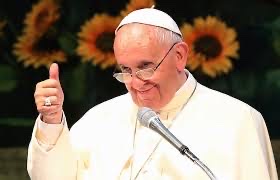The Mass - Meal and Sacrifice - Pre and Post Vatican II and Conclusion PART 8
PART 8 - THE MASS - PRE AND POST VATICAN II
The Universal Church has never had one standard form of celebrating the Mass. Various Eastern Churches all celebrated the Eucharist in styles different in great and small ways from what was common the the West, each using local languages. At the time of the Council of Trent, there were differences in missals used throughout Europe. In order the standardize the ceremonies of the Mass and as one means of reform in the face of the Protestant Reformation, the Council of Trent authorized the publication of a revised missal to be used by all western Catholics. First published in 1570, this Roman Missal is often called the Tridentine missal after the Council of Trent. It was in use, with few modifications, for nearly four centuries, until the revision following the Second Vatican Council.
The Tridentine Mass held the piety of the people and established an ambience of prayer, awe, and mystery through practices many contemporary Catholics have all but forgotten. However, in many cases what occupied the peoples attention the most were things that were secondary to the liturgy, such as the use of bells during the Eucharistic prayer and before communion, the music, the artistry in the Church (such as stained glass windows and statues), and devotional items (such as votive candles). In most places, it was common during the Mass for the people present to say the rosary, light vigil candles, or quietly recite private prayers while a choir sang hymns or an organist played instrumental music. This situation sometimes led to attitudes by the clergy and pastors that inhibited renewal and participation where permitted.
The vision embraced by the Second Vatican Council was intended to regain the spirit of the early Church’s liturgical celebrations. The “meal” and community aspects were to once again be emphasized. The Council Fathers declared that active and conscious participation by all present should be the norm for the liturgy, even if that meant changing the centuries-old prohibition against using the vernacular languages in the Roman rite. Part of the general revision involved composing a new lectionary that included three scripture readings for Sundays and major feast days, and that spread out the biblical proclamation over a three year cycle based on the three synoptic gospels. Instead of a priest doing everything by himself at the altar, the revised vision called for a coordination of ministries and for the liturgy to take place at different points in the Church, that is, at the chair, the ambo, and the altar.
The revised Order of Mass was first published in 1969. It introduced significant changes, the most obvious included the language of the liturgy and the posture of the priest, now standing at an altar, which, in imitation of the ancient Roman basilicas, should be designed so that the priest can face most of the assembly. In the old missal, the peoples presence was mostly ignored. Now the emphasis is on the communal celebration by the entire assembly, on full and active participation, on praying the Mass rather than merely praying during the Mass.
PART 9 - CONCLUSION
Over the past two thousand years, we have come a long way in out knowledge and understanding since Jesus said the words, “This is my body which is given up for you. Do this for a commemoration of me.” The Apostles initially viewed this as an important meal. This “meal” slowly evolved into a ritual, and eventually into a very elaborate liturgy. The physical reality slowly revealed the spiritual reality that is present within the Eucharist and Mass. As controversies and conflicts arose, the sacrificial and sacramental natures of the Eucharist were clarified and brought to light. The thoughts on how Jesus was present in the Eucharist went from the extremes of “not at all”, to “actually physically present”, with neither one being correct.
Philosophy was brought in to help clarify the Real Presence, with the thoughts of St. Thomas Aquinas being very important. Throughout history, the Church emphasized the meal and sacrifice aspects of the Mass at different times, each causing its own difficulties. What started as a meal with much joy and participation, eventually turned into a solemn, distant gathering with very little participation. The Second Vatican Council, with it’s changes to the Mass, especially the use of the vernacular, returned to emphasizing the meal and communal aspects of the early Church.
There’s one thing that we know for sure. Even though a mystery, our knowledge and understanding of the Eucharist continues to grow, and whether viewed as a sacramental meal, sacrifice, or both, will continue to feed us and the world until the end of time.

Comments
Post a Comment